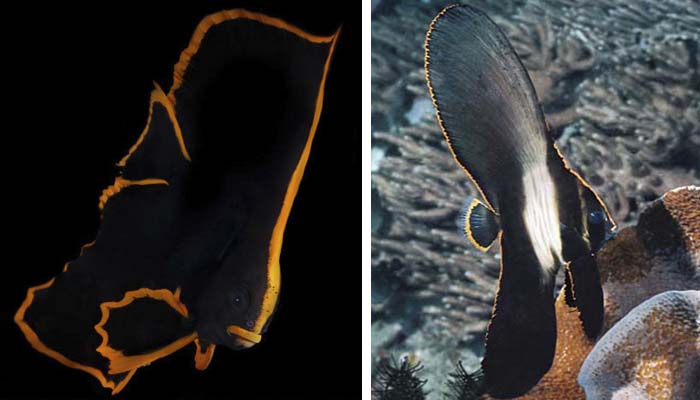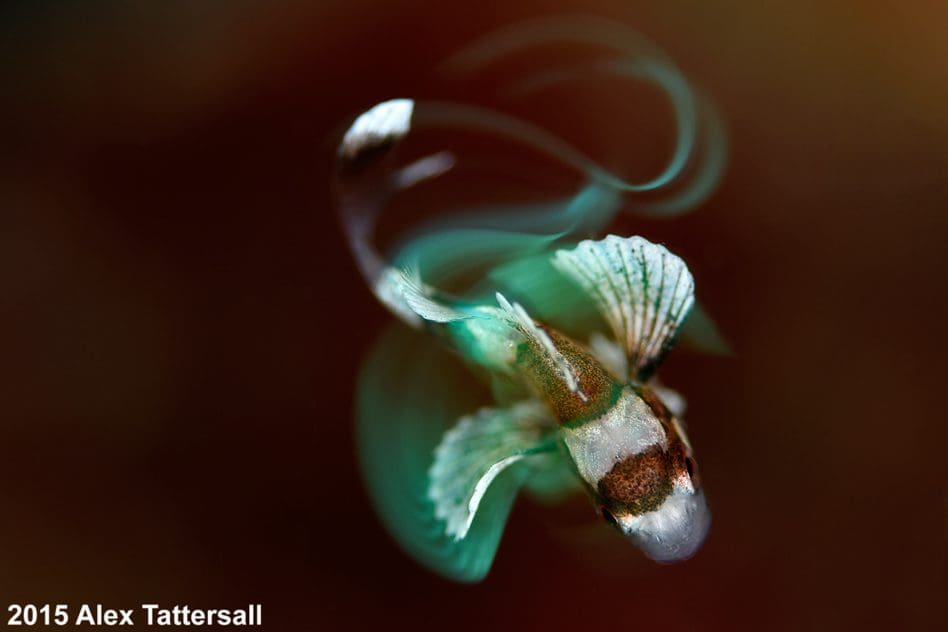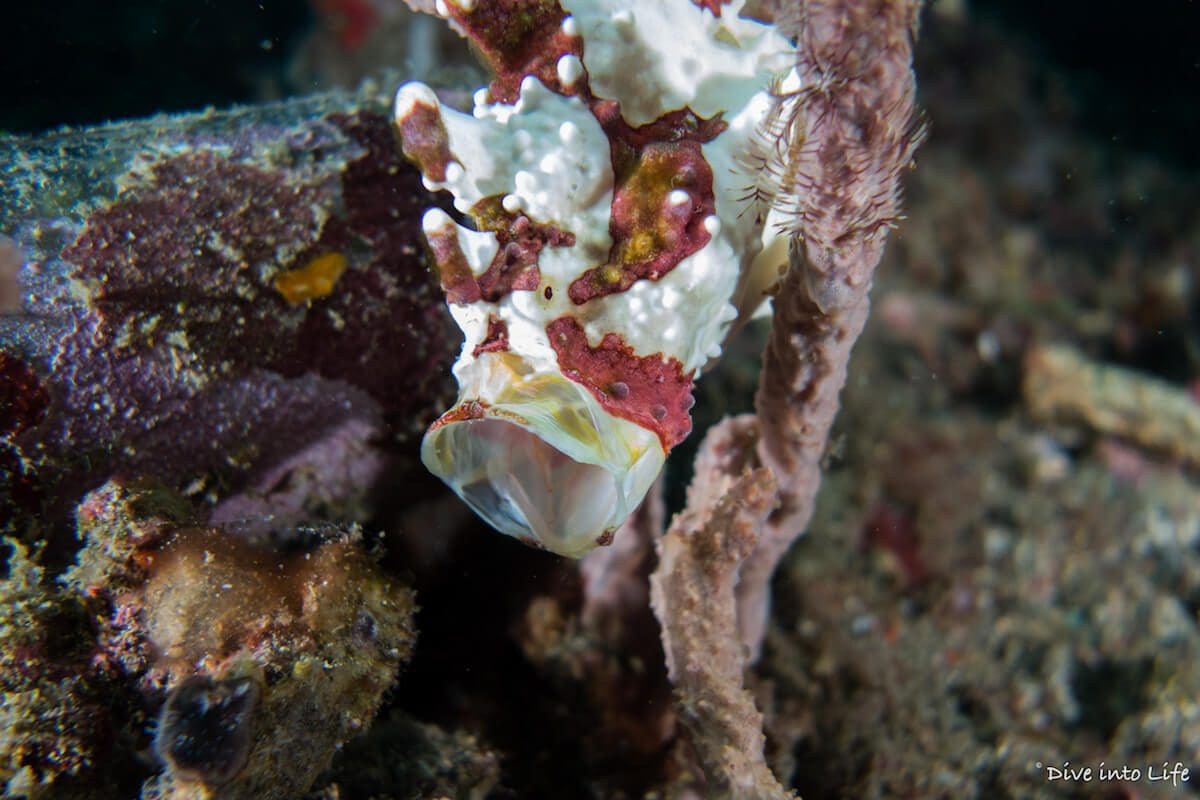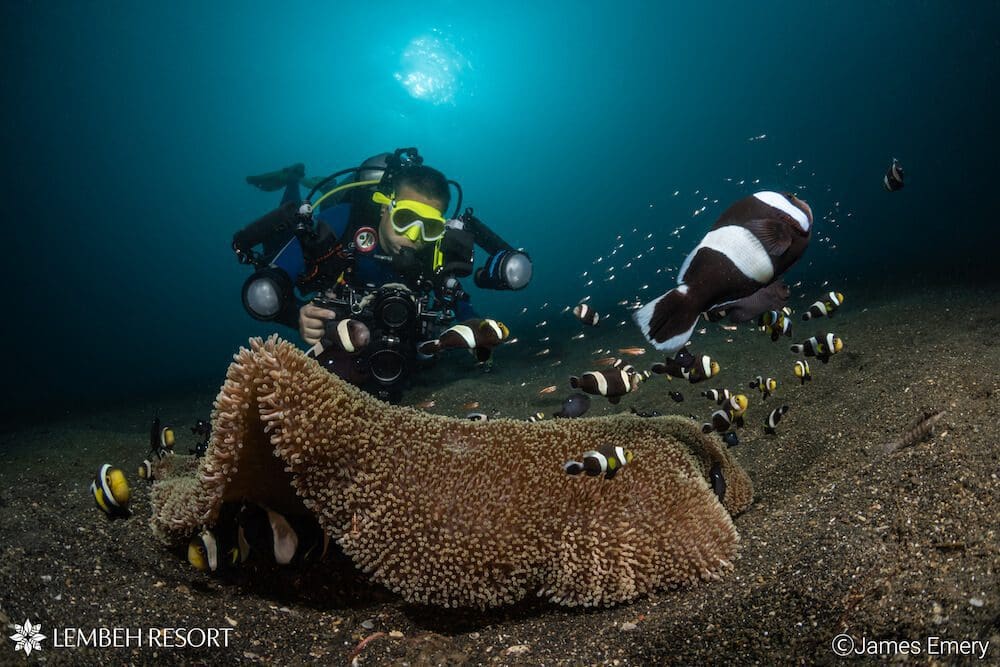Pinnate Batfish vs. Harlequin Sweetlips
The Lembeh Strait is well known for its sheer abundance of rare and unusual marine life, and the majority of our most iconic critters are cephalopods, crustaceans or bottom dwellers. However, the Lembeh Strait is also home to a myriad of reef fish too – some of which display equally unique behavior and characteristics as some of our critters. In this article we look at two common reef fish that are anything but boring as they transition from juveniles into adults – meet the Pinnate Batfish and Harlequin Sweetlips….
The Multiple Names of Pinnate Batfish and Harlequin Sweetlips
Pinnate Batfish (Platax pinnatus)

Pinnate Batfish
Batfish are also known as spadefish (the terms are interchangeable) due to their adult body shape. The pinnate batfish is also known as the longfin batfish/spadefish, pinnatus batfish/spadefish, dusky batfish/spadefish, shaded batfish/spadefish, and the orange lined batfish/spadefish. The last name in this list comes from the appearance of the juvenile form.
Harlequin Sweetlips (Plectorhinchus chaetodonoides)

Harlequin Sweetlips
This species is also known as the clown sweetlips, the spotted sweetlips, or the many spotted sweetlips. All of these names relate to both the adult and the juvenile forms. The juvenile form alone is sometimes called the dancing sweetlips.
The Unique Juvenile Forms of Pinnate Batfish vs Harlequin Sweetlips
Pinnate Batfish
The juvenile form of the pinnate batfish has to be among the most striking of all juvenile forms found beneath our seas. Juvenile pinnate batfish are jet black all over aside from a bright orange margin that outlines their entire body and median fins. The juveniles have more elongated dorsal and anal fins when compared to mature individuals.
Juvenile pinnate batfish individuals are solitary and they are most frequently found hiding out in caves or other shady recesses and underneath ledges.
Harlequin Sweetlips
It’s not only the appearance of this juvenile form that makes it easily identifiable. It’s also the way it moves – or never stops moving! This juvenile is usually in a head down position while it wildly undulates its body continuously (AKA wiggling) which is where the juvenile name, the dancing sweetlips, originates from.
Visually the juvenile harlequin sweetlips has a brownish orange body which is covered in large creamy blotches (often almost circular). The fin tips of the juveniles fins also have creamy to white patches.
Juvenile harlequin sweet lips are also solitary and they are most commonly spotted inside branching and other corals that provide them with hiding spots from predators.
Mimicry in Juvenile Pinnate Batfish vs Harlequin Sweetlips
Pinnate Batfish
The juvenile pinnate batfish is thought to mimic a toxic flatworm in shape, color and movement to ward off predators.
Harlequin Sweetlips
Similar to the pinnate batfish, it is thought that the wild undulations of the juvenile harlequin sweetlips’ body is an attempt to mimic swimming platyhelminths (flatworms) and unlike pinnate batfish, the round blotches may be an attempt to mimic the body markings found on certain nudibranch.
The Adult Transformation of the Pinnate Batfish vs Harlequin Sweetlips
Pinnate Batfish
As pinnate batfish mature they begin to stretch out and elongate. Fully mature pinnate batfish have a rounded yet compressed body and can grow up to over 35cm in length. They have protruding snouts with a concave side profile to the head. Their bodies are a silvery color with a darker (dusky colored) vertical bar running through the eye and a second, parallel bar running through the base of the pectoral fin. Their dorsal, anal and caudal fins are a light yellow that blends seamlessly into their silver bodies.
Harlequin Sweetlips
As the harlequin sweetlips matures its fleshy lips become increasingly swollen (the origin of the name ‘sweetlips’) and their coloration begins to develop a greyish base color that is broken up by large, dark brown to black spots. Mature harlequin sweetlips have an average length of around 60cm although individuals have been recorded up to 72cm.
Other Juvenile to Adult Shape Shifting Fish in Lembeh
It’s not only the pinnate batfish and harlequin sweetlips that change their physic appearance, shape and color from being a juvenile to becoming a mature fish in Lembeh. Here are some of the other ‘shape shifters’ that we see in the Lembeh Strait…
Emperor Angelfish
Juvenile emperor angelfish have black bodies with striking light and almost ultra violet blue markings (a mix of blue lines and black spot patterns). The juvenile emperor angelfish displays no yellow markings at all while the adult emperor angelfish has a blue body with bright yellow parallel strips (between horizontal and diagonal), a bright yellow tail fin, blue snout and a bright blue margin (similar to a mask – AKA the masked angelfish) circling the black area around the eyes.
Warty Frogfish

This yawning warty frogfish was shot by Dive into Life
The juvenile warty frogfish displays such a different coloration to its adult form that it is often referred to as the clown frogfish but this is not a unique species. If you look closely, you will see that the orange markings on the juvenile warty frogfish are exactly the same as the redish markings found on the adult warty frogfish. Aside from the difference in size, the key differences are that the juvenile form has a smooth body which is bright white while the adult has a warty appearance and a yellow body.
Bicolor Parrotfish
This is probably one of the most significant transformations seen on Indonesian reefs. The juvenile bicolor parrotfish has a completely bright white body with an equally bright wide vertical orange band that passes through the eye (also orange) and around the rear of the head that is edged in black. There is a small bright orange flash on the tail fin and the dorsal fin has black and orange markings. In stark contrast the adult bicolor parrotfish has an iridescent blue and green body with pink anal fin, blue and yellow pectoral fins, a beak shaped mouth, and a bright blue tail fin – there are no traces of white, orange, or a vertical band around the head anywhere to be found!
Other Marine Species

Ribbon Eels
Among other species that we see changing from juveniles to adults are the barramundi cod, ribbon eels, the yellowtail coris, and some box and pufferfish species.
Underwater Photography of Juvenile Fish (and other fast moving fish)
Due to many juvenile fish being skittish, or relying on movement for mimicry purposes (for example the harlequin sweetlips and barramundi cod), it’s important to adjust your approach and camera settings to be able to capture a strong image despite the movement.
Essential Techniques for Approaching

As with all critters in Lembeh, when approaching a juvenile stay low and go slow – but even more so… Juveniles tend to be extremely shy and they are easily scared away. Approach juveniles slowly and, as always, we recommend taking incremental images while approaching to ensure that you get at least a couple of shots before the juvenile moves away. Make sure you are neutrally buoyant and aim to keep your fins as still as possible. Excessive finning will spook the juvenile and stir up the fine silt bottom, creating backscatter in your images.
Settings for Different Speeds of Movement
If your compact camera offers an aperture priority (Av) mode, use this. With both AV mode and on a DSLR try using an aperture of F2.8 (you can also use Program (P) mode on a compact camera for wide-angle shots).
Start with an ISO of 100 but be prepared to increase this when using an aperture of F2.8 until you find the ‘sweet spot’. Your shutter speed should ideally be below 1/30 if the subject is still, 1/60 if they’re moving slowly, and 1/125 if they’re fast-moving like many juveniles.
If you want to work on your underwater photography during your stay, talk to our Photo Center team in our Backscatter Authorized Photo Center for tips and advice!
Book Your Stay With Us at Lembeh Resort

If you are ready to book your stay with us – or would like more information about our rates and availability contact us at reservations@LembehResort.com.
Our reservations team looks forward to assisting you!
Further Reading
If you enjoyed reading this article about marine life found in the Lembeh Strait and the Indo-Pacific, you may also enjoy some of our other marine life articles too…
Pygmy Seahorses In The Lembeh Strait
The Hairy Shrimp: Phycocaris simulans
Colors And Combat: Exploring The Tiger Mantis Shrimp In Lembeh


